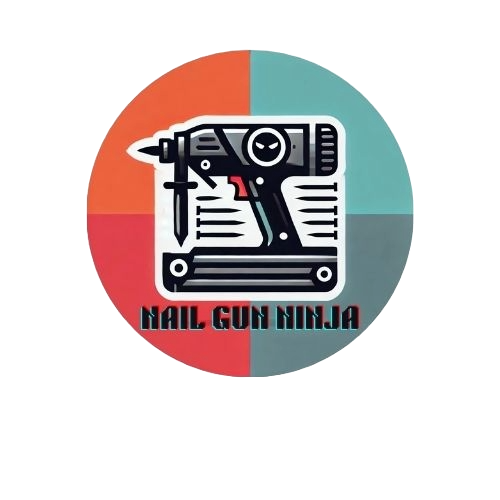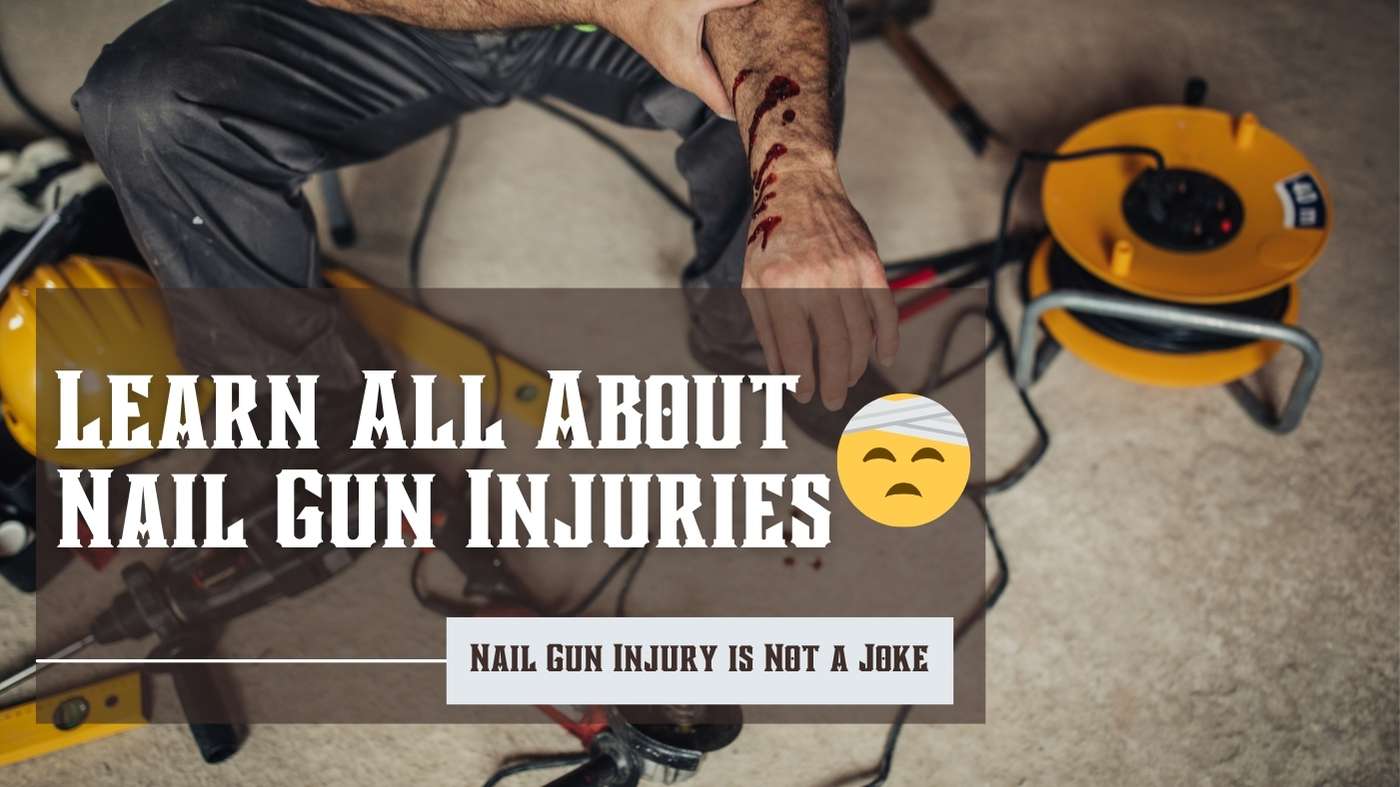Nail guns are powerful tools. They make construction and DIY projects faster and easier. But they can also be dangerous. nail guns cause an estimated 37,000 emergency room visits each year in the U.S. Nail gun injuries happen more often than one might think. Every year thousands of people are hurt by nail guns. These injuries can be from minor cuts to life-threatening accidents.
But why do these injuries happen? Is it user error, faulty equipment, or something else? Understanding the causes and risks behind nail gun injuries can help you stay safe.
Whether you’re a professional or a DIYer, you should know how to prevent injuries. In this guide, we’ll go through the common causes, real-life examples, and safety tips so that you can keep yourself protected.
Common Causes of Nail Gun Injuries
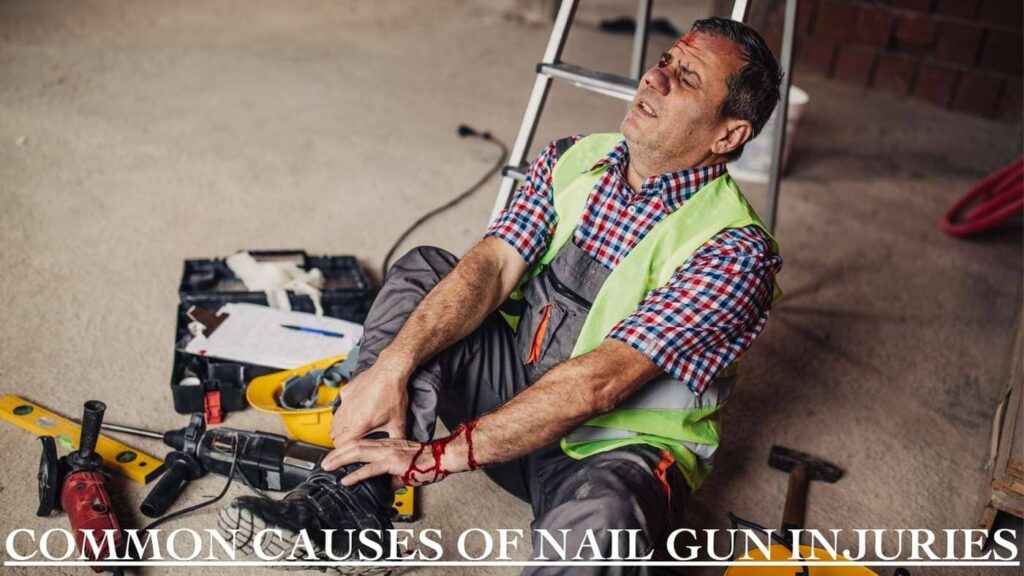
Improper Handling by Users
Many nail gun injuries are caused by mishandling the tool. Mishandling includes pointing the tool at oneself or others.
If the user is inexperienced, lacks enough focus, or is overconfident, it can lead to accidents. Proper training and abiding by safety protocols are essential to handle nail guns better.
Using the Wrong Trigger Mechanism
Nail guns come with two main trigger types. They are sequential triggers and contact triggers. Contact triggers are also called bump fire modes.
They help in rapid firing but increase the risk of accidental discharge. You must be careful with contact triggers especially when working in tight spaces.
Equipment Malfunctions
Nail guns contain different components like nails, magazines, triggers, batteries, and many other parts. Sometimes the nails jam inside the magazine and the components misalign or become worn out.
This can cause the nail gun to fire unnaturally. Routine maintenance and inspections help reduce these risks.
Misfires and Ricochets
Misaligned nails or imperfectly positioned components can cause nails to deflect. This deflection can cause injury to the user.
Correct positioning and surface assessment are important to protect oneself from this risk.
Lack of Personal Protective Equipment (PPE)
Neglecting the use of basic nail gun safety gear like goggles, gloves, or sturdy boots makes users vulnerable to injuries from nails. Proper PPE reduces the severity of injuries.
Fatigue or Distracted Work
Continuing to work with fatigue dulls the concentration and reaction times of the user. This lack of concentration increases the chances of accidents.
Handling more than one task at a time or being distracted by things like loud noises, increases the risks further.
Using Inappropriate Nails or Fasteners
Using nails that are too large, too small, or incompatible with the nail gun can lead to jamming or misfiring.
Moreover, jamming and misfiring put the user in danger. Using manufacturer-recommended nails is important to prevent these risks.
Types of Nail Gun Injury and Their Impact
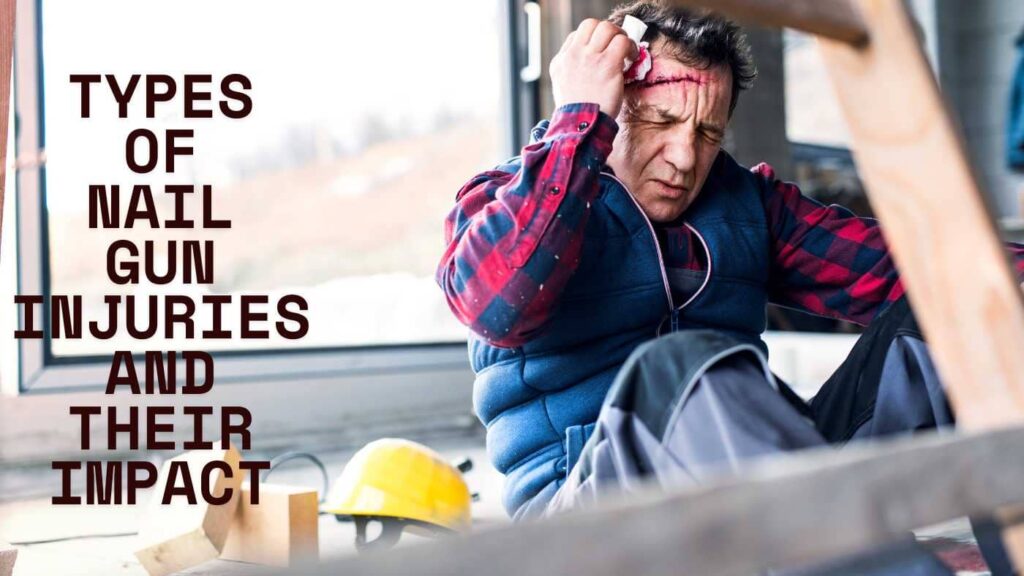
Nail Gun Finger Injury
Finger injuries happen often with nail guns. Fingers are usually near the nailing area. Nails can go into and crush the fingers.
This causes pain, swelling, and bleeding. Severe injuries can hurt the bones or nerves in the fingers. This makes it hard to move or bend them.
If a nail stays stuck in the finger, a doctor must remove it. The recovery process can take weeks. To avoid this, keep your fingers away from the nailing point. Use a sequential trigger to reduce the chances of misfires.
Nail Gun Hand Injury
Hand injuries happen when the nail gun misfires or slips. A nail can make a hole in the skin or go deep into the hand. This can damage bones or joints.
Serious injuries might cause fractures or harm nerves. These injuries can weaken the grip of the hand. Infection is a big risk because hands touch dirt and bacteria often.
Gloves can protect your hands. Following safety rules can also help prevent these injuries.
Nail Gun Head Injury
Head injuries with nail guns are rare but very serious. These injuries often happen when a nail bounces back from a hard surface.
Sometimes they happen because of poor handling. A nail in the head can cause skull damage or brain injury. There may be heavy bleeding too.
These injuries need urgent medical care. They can be life-threatening. To avoid such injuries, wear a hard hat in work zones. Be very careful about where and how you fire nails.
Nail Gun Injury to Bone
A nail can hit a bone if fired with strong force. This can break the bone or make a nail get stuck in it. Injuries like this can happen to the hands, feet, or legs.
They make it hard to move the affected area. Serious injuries to bones need surgery. Doctors must remove the nail and fix the damage.
Recovery from these injuries can take a long time. Physical therapy may help bring back strength and movement.
Eye Injuries
Nails can misfire or bounce back and hit the eyes of the user. This can cause scratches, cuts, or serious damage to the eye. In some cases, it can lead to blindness.
Eye injuries can be very painful and may need immediate medical help. Wearing safety goggles can protect the eyes and prevent these injuries.
Nerve Damage
Nails can misfire and go deep into the body and injure nerves. When this happens, a person may lose feeling or have constant pain in the affected area.
Some injuries can make it hard to move a hand, foot, or other body parts. Recovery from nerve injuries is slow and may need special exercises or therapy.
Infections and Sepsis
A nail gun wound can become infected if bacteria get into the open skin. If the infection is not treated, it can spread to other parts of the body.
In serious cases, it can cause sepsis and it is life-threatening. Cleaning the wound and seeing a doctor quickly can help prevent infections.
Psychological Effects
Serious nail gun injuries can affect a person’s mental state. They may feel scared to use tools again. Some people lose confidence in doing similar work.
Others may feel anxious or frustrated about their injury. Talking to a counselor can help with these feelings and improve recovery.
Rebound or Ricochet Trauma
Sometimes a nail hits a hard surface and bounces back. As a result, the nail can hit the user or someone nearby. These injuries can be small, like cuts or bruises.
But they can also be serious if the nail hits with a lot of force. Being careful around hard surfaces reduces the risk of these injuries.
Nail Gun Injury Treatment
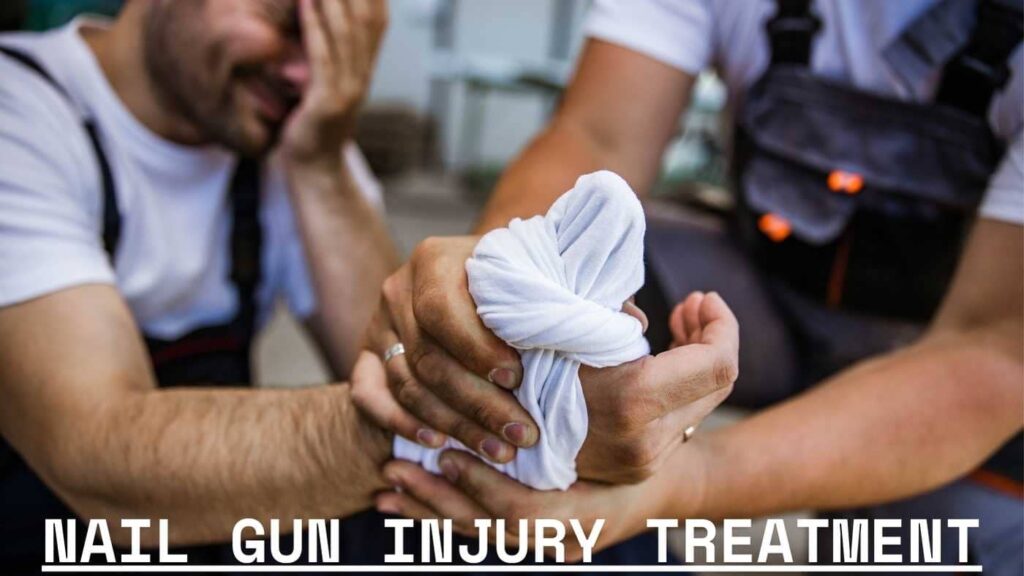
Treating nail gun injuries depends on how serious the injury is. Proper care is very important. It helps to stop more damage and prevent infections or other problems.
First Aid for Minor Injuries
Small wounds can be treated at home. Wash the wound with soap and water to remove dirt. Use an antiseptic to kill germs and reduce infection risk.
Cover the wound with a clean bandage to keep it safe from bacteria.
Treatment for Embedded Nails
Do not try to pull out a nail stuck in the body. Removing it can cause more bleeding or damage. Keep the injured part still and go to a doctor.
The doctor may take an X-ray to check for hidden injuries. They will then remove the nail safely and treat the wound.
Addressing Bone or Joint Injuries
If a nail hits a bone or joint, you need immediate medical help. This kind of injury is very serious. The doctor might need to do surgery to remove the nail and fix broken bones or joints.
A cast or splint might be needed to help the area heal.
Dealing with Nerve Injuries
If a nail damages a nerve, it can cause numbness, pain, or trouble moving. This type of injury needs a doctor’s attention. The doctor may perform surgery to repair the nerve.
After surgery, therapy can help restore strength and movement. Recovery may take a long time.
Preventing and Treating Infections
Nail gun injuries can lead to infections. A wound can get infected if germs enter through the open skin. A doctor may give antibiotics to stop this from happening.
Signs of infection include redness, warmth, and fever. If these appear, you should see a doctor right away. In serious cases, infections can cause sepsis, which is very dangerous.
Handling Eye Injuries
Eye injuries from nail guns are very serious. If something enters the eye, do not touch it or try to remove it. Cover the eye gently with a clean cloth.
Go to a hospital as quickly as possible. A specialist may need to perform surgery to save your vision.
Managing Severe Bleeding
Heavy bleeding needs quick attention. Use a clean cloth to press on the wound and slow the bleeding. Raise the injured part if you can.
This helps reduce the blood flow. Call emergency services or go to a hospital right away.
Psychological Recovery
Serious injuries can affect the mind. Some people feel scared to use tools again. Others lose confidence in their work. This can cause stress and anxiety.
Talking to a counselor or therapist can help. It can make recovery easier and improve emotional health.
Follow-Up Care and Rehabilitation
After the first treatment, follow-up visits are very important. A doctor can check for hidden problems like infections or nerve damage.
Physical therapy may be needed to help you move the injured part again. This is especially true for serious injuries.
Best Practices to Abstain from Nail Gun Injury
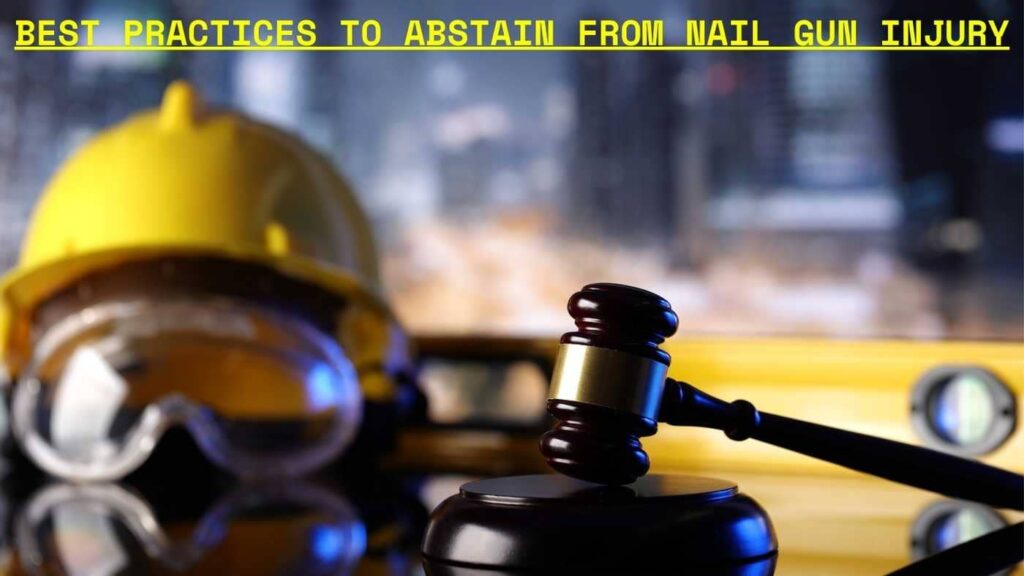
Use the Correct Trigger Mechanism
Choose a sequential trigger for the nail gun. This type of trigger is safer. It needs you to press the safety tip and then pull the trigger for each nail. This reduces the risk of firing nails by mistake.
Wear Appropriate Personal Protective Equipment (PPE)
Always wear safety gear when using a nail gun. Use goggles to protect your eyes from flying nails or debris. Gloves can protect your hands from cuts or punctures.
Strong boots can shield your feet from falling nails. Wearing proper gear can make injuries less severe.
Thoroughly Inspect the Tool Before Use
Check the nail gun before you start. Look for worn-out parts or loose screws. Make sure there are no jams. A damaged tool can malfunction and cause injuries.
Regular maintenance can help keep the nail gun safe and reliable.
Follow the Manufacturer’s Guidelines
Always read the manual before using the nail gun. Use the right nails for the tool. Follow the recommended settings. If you misuse the tool, it can malfunction or cause injuries.
Secure and Stabilize Work Surfaces
Make sure the surface you are working on is stable. Do not use the nail gun on uneven or soft surfaces. Unstable surfaces can cause the nails to misfire or bounce back.
Keep Hands and Body Away from the Firing Zone
Do not let your hands or body get too close to the nail gun’s firing area. Keep a safe distance from where the nail enters. If you need to hold the material, use clamps instead of your hands.
Stay Focused and Avoid Distractions
Work in a quiet and well-lit area. Do not let anything distract you while using the nail gun. Fatigue can also make you lose focus. If you feel tired, take a break.
Participate in Proper Training
Learn how to use a nail gun before trying it. Training teaches you about the tool’s features and how to handle it safely.
Proper training helps you feel confident and reduces the risk of accidents. Both professionals and DIY users should be trained.
FAQs
1. What is the ICD-10 code for a nail gun injury?
Ans: The ICD-10 code for nail gun injuries is W29.4 – “Contact with the nail gun.” This code is used to determine the external cause of the injury.
Moreover, it is a medical classification that is listed by WHO under the range of external causes of accidental injury. The ICD-10 code may vary based on the seriousness and location of the injury.
2. How does nail trauma happen?
Ans: Nail trauma happens when a nail is fired too forcefully. It can be caused by misfires, faulty tools, or nails bouncing off surfaces. Sometimes, the nails go deeper into the body and cause serious damage.
3. Can nail gun injuries be fatal?
Ans: Yes, nail gun injuries can be fatal in rare cases. If a nail hits important organs or blood vessels, it can cause serious harm or even death. Getting help right away is important.
4. Can nail gun injuries lead to long-term damage?
Ans: Yes, some nail gun injuries can cause prolonged damage. Nerve or bone damage can be permanent. Infections can also cause severe problems if not treated quickly.
5. What is the most common type of nail gun injury?
Ans: The most common injury is a penetrating wound. This happens when a nail goes through the skin. It usually happens on the hands, feet, or legs.
